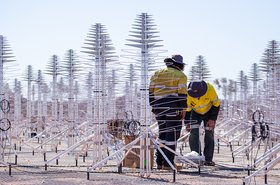The 1pm to 2pm keynote panel of Inside_Australia on Thursday 13th May will look at the factors that will drive Australia towards sustainability and the role that data centers will play in this process. Each of the three panelists brings a different perspective to the discussion: Adam Gibson is Head of data centers at the Springfield City Group, Parastoo Amin is researching and writing her PhD as a data centrer researcher at RMIT University, and Christopher Quint is Senior Business Development Manager at Enel X.
A number of key elements of this debate are considered in Parastoo Amin’s PhD into the diffusion and value of international ‘green’ data center standards [GDCS]. She will share further insights from her research and analysis as part of the panel as well as providing comparisons between the Australian data centers sampled and overseas markets. The research undertaken addresses three key questions:-
- What is the extent to which GDCS are adopted among data centers?
- Why do data centers adopt GDCS?
- How does the adoption of GDCS contribute to a data center’s environmental and operational performance?
The study collected data from 176 data centers across the world and looked mainly at adoption in four areas of the data center:- IT, cooling, power and monitoring.
The findings show a considerable variation in the adoption of GDCS among data centers. In particular, data centers are more focused on using GDCS for mechanical and electrical infrastructure than on the adoption of such standards for IT infrastructure. Does this suggest that the unbalanced situation whereby the facility looks at its footprint closely while IT efficiency is barely considered, remains?
This study indicates that adoption of Government regulations and industry-wide standards and commitments to ‘green' IT practices are significant means whereby data centers can improve both their operational and environmental performance. So, is the idea that the data center can do one or the other but not both now being effectively challenged?
The most important factors that drive adoption among data centers is compatibility with current equipment, policies, environmental attitudes and local regulation, as well as situations where the data centre:
- Has already developed knowledge and understanding of the requirements of data center sustainability,
- Employs well-trained and informed employees who are more prepared and ready to adopt these standards,
- Is more involved in joint actions, collaboration projects and conducting research on ‘green’ data centers.
The results show the significant role of organisational commitment to environmental performance in adoption of GDCS. This indicates the importance of having environmental performance advocates plus clear goals and policies for energy optimisation, energy transparency, measuring and improving environmental performance in a data center.
Key to the process is the capability of delivering outcomes. Data centers with higher rates of adoption reported greater improvement in energy productivity, energy efficiency, transparency and PUE scores while maintaining levels of resiliency and reliability. Those who had measured their carbon emission could reduce CO2 emissions by 7.2% on average as a result of adopting GDCS. For a major data center, that could also mean a major reduction in carbon-related costs.
To register, please go to Inside_Australia - the virtual event for the Australian data centrer industry on 13 May 2021.
Wider reading...
-

Understanding the future of lithium
Batteries will power the next decade, but companies need to ensure that their supply is as sustainable and ethical as they claim
-

Australian gov to spend $64m on Pawsey Square Kilometre Array supercomputer
Funding will come over a decade, joining a number of supercomputing efforts for the SKA
-

Issue 40: How data centers survived the Texas storm
Texas froze over, data centers burned down, and semiconductor fabs struggled with drought. The last three months have been chaos, but data center resiliency has helped the industry prevail.

